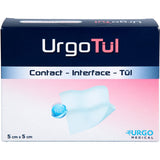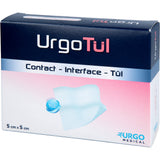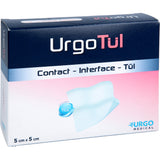URGOTÜL 5x5 cm wound gauze
- Pack size:
- 40 pieces
- Dosage form:
- wound gauze
URGOTÜL 5x5 cm wound gauze benefits:
Pain-free dressing changes. Moist wound-healing. Improvement of surrounding skin. Clinically proven.
UrgoTul has pro-healing efficacy, stimulating the proliferation of fibroblasts – enabling the key cells for healing. The benefits of TLC: Provides and maintains a moist environment that promotes healing. Atraumatic removal that doesn't damage any newly formed granulation tissue.
Due to its ability to absorb wound exudate and the formation of an eschar, gauze wound dressings were believed to stimulate wound healing. This is because, at the time, a dry wound microenvironment was believed to be conducive to wound healing through the inhibition of bacterial growth.
UrgoTül
UrgoTül is a lipidocolloid technology (TLC) product developed by Laboratoires URGO. UrgoTül is a non-occlusive, flexible, and conformable lipidocolloid gauze wound dressing consisting of a mesh of polyester fibers impregnated with hydrocolloid particles (carboxymethylcellulose), paraffin, petrolatum, and polymers.
Properties:
In contact with wound exudate, the hydrocolloid particles gel and, together with the petrolatum component of UrgoTül, form a lipidocolloid boundary layer. This creates favorable conditions for the healing process (healing in a moist environment). Due to its chemical composition, which is non-greasy to the touch, UrgoTül does not adhere to the wound or wound edges, making dressing changes painless and atraumatic for the patient.
This results in the following specific properties:
- Maintaining a moist environment favorable for wound healing.
- Atraumatic detachment for the newly formed tissue.
- Pain-free dressing changes for the patient.
Indications:
UrgoTül is used to treat:
- acute wounds (burns, skin abrasions, traumatic wounds, postoperative wounds), chronic wounds (pressure ulcers, lower leg ulcers, diabetic foot ulcers) in the granulation and epithelialization phase.
- Wounds as a result of the hereditary disease Epidermolysis Bullosa.
Due to its flexibility and excellent adaptability, UrgoTül is particularly suitable for covering fissured wounds or wounds in difficult locations, as well as for packing deep wounds.
Instructions for use:
Clean the wound according to standard care protocol. If an antiseptic has been used previously, rinse the wound thoroughly with physiological saline solution before applying UrgoTül. Remove the protective film from UrgoTül. Apply UrgoTül directly to the wound. UrgoTül can be trimmed with a sterile instrument to adapt the size of the dressing to the wound and the surrounding area. Cover UrgoTül with a secondary dressing adapted to the exudate volume and secure it with an expandable bandage, an expandable adhesive plaster, or an elastic tubular bandage. UrgoTül is changed every 2 to 4 days, depending on the wound being treated and the clinical condition of the wound. UrgoTül can be left in place for up to seven days, with multi-layer compression for venous leg ulcers. When treating wounds resulting from the hereditary disease epidermolysis bullosa, the wound dressing should be changed every one to three days.
Warnings and Precautions:
- UrgoTül adheres to disposable latex surgical gloves. To facilitate handling of UrgoTül, it is advisable to moisten the gloves with physiological saline solution.
- If clinical signs of local infection are present, treatment can be switched to an antibacterial wound dressing after consultation with the attending physician.
- In the case of a deep, fissured or fistulous wound, UrgoTül should be positioned so that part of the dressing remains visible and easily accessible outside the wound.
- UrgoTül must not be used in a hyperbaric chamber.
- Sterile individual packages are intended for single use only. Reusing a single-use wound dressing may cause infection.
- Check the integrity of the sterile individual packaging before use. Do not use if it is damaged.
- Do not re-sterilize the wound dressing.
Contraindications:
Known hypersensitivity to the wound dressing.






